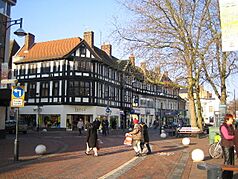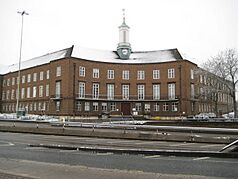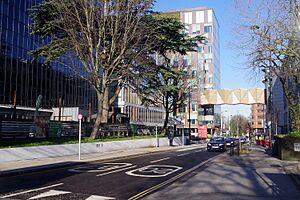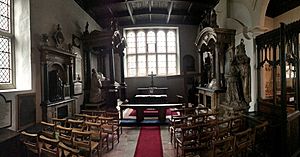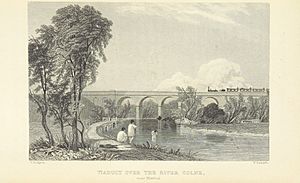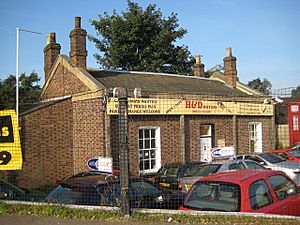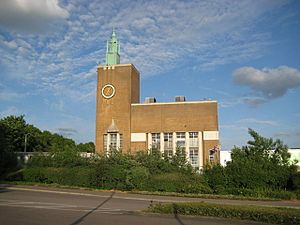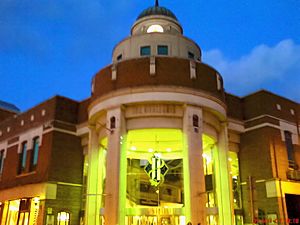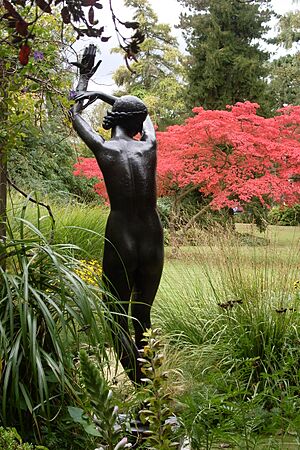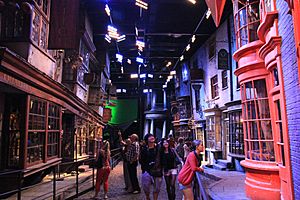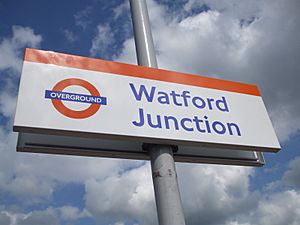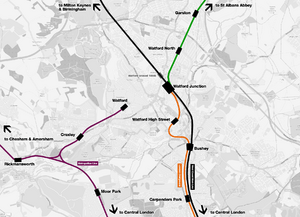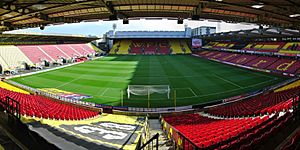Watford facts for kids
Quick facts for kids
Watford
|
|
|---|---|
|
Town, local government district, non-metropolitan district, borough
|
|
|
|
|
| Motto(s):
Be Bold
|
|
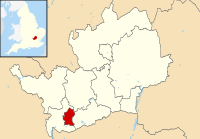
Watford within Hertfordshire
|
|
| Sovereign state | United Kingdom |
| Country | England |
| Region | East of England |
| County | Hertfordshire |
| Borough | Watford |
| UK Parliament constituency | Watford |
| Government | |
| • Type | Non-metropolitan district |
| Area | |
| • Borough | 8.301 sq mi (21.50 km2) |
| Elevation | 233 ft (71 m) |
| Population | |
| • Borough | 102,246 |
| • Density | 12,317.3/sq mi (4,755.74/km2) |
| Ethnicity (2021) | |
| • Ethnic groups |
List
|
| Religion (2021) | |
| • Religion |
List
44.4% Christianity
24.8% no religion 17.8% other 13% Islam |
| Time zone | GMT |
| • Summer (DST) | UTC+1 (Summer Time (British)) |
| Postcode area |
WD
|
| Area code(s) | 01923 & 020 |
Watford (pronounced WOT-fərd) is a town in Hertfordshire, England. It's about 15 miles (24 km) northwest of Central London, located by the River Colne.
Watford started as a small market town. The Grand Junction Canal (now the Grand Union Canal) helped it grow, leading to factories for paper, printing, and even breweries. While many of these industries have now closed, Watford's close location to London and its good transport links have made it a popular spot for many companies to set up their main offices. Cassiobury Park is a large public park that used to be the private estate of the Earls of Essex.
The town first grew next to the River Colne on land owned by St Albans Abbey. In the 1100s, the town was given permission to hold a market, and work began on St Mary's Church. Watford became more important as travellers passed through on their way to places like Berkhamsted Castle and the royal palace at Kings Langley. Later, large homes were built at Cassiobury and The Grove.
The arrival of the Grand Junction Canal in 1798 and the London and Birmingham Railway in 1837 caused Watford to grow very quickly. Paper-making factories, like John Dickinson at Croxley, helped the printing industry develop in the town. Two breweries, Benskins and Sedgwicks, became very successful here before closing in the late 1900s. Today, Hertfordshire County Council sees Watford as a major regional hub. Many company headquarters are based in Watford. Big international events have also happened here, including the 2006 World Golf Championship and the 2019 NATO summit, both held at The Grove.
Watford became an urban district in 1894 and a municipal borough in 1922. In 2021, the borough had 102,246 people living there. It is separated from Greater London to the south by the Three Rivers District. Watford Borough Council is the local government, led by the Mayor of Watford.
Contents
- History of Watford
- Watford's Location and People
- How Watford is Governed
- Watford's Economy
- Parks and Gardens in Watford
- Historic Buildings in Watford
- Theatres in Watford
- Museums in Watford
- Transport in Watford
- North of Watford Expression
- Education in Watford
- Media in Watford
- Sports in Watford
- Notable People from Watford
- Freedom of the Borough
- See also
History of Watford

How Watford Began
There's some proof that people lived around Watford long ago, with a few ancient Celtic and Roman items found. However, there's no sign of a proper town until much later. Watford is located where the River Colne could be easily crossed. This was important for an old pathway that ran from the southeast to the northwest. Watford's High Street still follows part of this old route today. The town was built on the first dry land above the wet, marshy areas near the River Colne.
The name Watford might come from an old English word "waet" (meaning "full of water" because the area was marshy) or "wath" (meaning "hunting"). The word "ford" means a shallow place in a river where you can cross. St Albans Abbey said they owned the land of Casio, which included Watford, from a grant by King Offa in AD 793.

The name Watford was first written down in an old Anglo-Saxon document from 1007. It's not mentioned in the Domesday Book of 1086, when this area was part of St Albans Abbey's land. In the 1100s, the Abbey was given permission to hold a market here, and construction of St Mary's Church began. The town's location helped it grow because it was good for trade along the north-south route. It also had good connections to the St Albans valley to the east and the Chiltern Hills to the west.
The town grew steadily, helped by travellers going to Berkhamsted Castle and the royal palace at Kings Langley. A large house was built at Cassiobury in the 1500s. It was partly rebuilt in the 1600s, and another big house was built nearby at The Grove. These houses were made bigger and improved over the next few centuries. Cassiobury became the home of the Earls of Essex, and The Grove became the home of the Earls of Clarendon.
In 1762, the Sparrows Herne Turnpike Road was created across the Chilterns. This toll road followed a similar path to the old A41 road. You can still see where a toll house was at the bottom of Chalk Hill, on the Watford side of Bushey Arches.
In 1778, writer Daniel Defoe described Watford as a "polite market town, very long, having but one street."
Watford's Growth During the Industrial Revolution
For many centuries, Watford was a farming community with some small home-based industries. The Industrial Revolution brought big changes. The Grand Junction Canal (now Grand Union Canal) arrived in 1798, and the London and Birmingham Railway in 1837. Both were built here because the land offered an easy way to cross the Chiltern Hills. Landowners allowed the canal to follow the River Gade closely. However, they didn't want noisy, smoky steam trains too close to their Cassiobury and Grove estates. So, the railway company had to build an expensive tunnel under Leavesden north of the town.
Watford's first railway station opened in 1837. It was a small, red-brick building. It closed in 1858 and was replaced by a bigger station, Watford Junction, a bit further southeast. The old station building is still there today and is a protected historic building.
These new transport links helped Watford's industries grow in the 1800s and 1900s. The Grand Union Canal brought coal, which helped factories develop. Paper-making mills, like the John Dickinson and Co. mill, were built next to the canal. This led to the growth of printing in the town. Brewing had been in Watford since the 1600s, and by the 1800s, two large breweries, Benskins and Sedgwicks, were operating in the town.
Watford grew steadily during this time. In 1851, a new street called King Street opened off the High Street. Then, Queens Road and Clarendon Road followed in the early 1860s. Around this time, Watford had about 6,500 people. The railways also continued to expand. The Watford and Rickmansworth Railway opened in 1862, connecting Watford to Rickmansworth. Another branch line was added to Croxley Green in 1912.
By 1891, Watford's population had grown to 17,063. Local landowners sold land for new buildings, and factories and businesses appeared. Most were breweries and printing companies, but there were also engineering works and a cocoa processing plant. The town grew very fast, with many new residents moving in from London.
Watford in the 1900s
At the start of the 1900s, Watford was still growing quickly. New roads were built in Callowland (North Watford) and West Watford. Many people still lived in crowded and unhealthy homes in the small yards and alleys off the High Street. Some of these people were involved in a riot in 1902 when the celebration for King Edward VII's coronation was delayed. The local council had a plan to clear these poor housing areas, but it stopped when World War I began in 1914. Building new council houses started again after the war, and the Harebreaks estate was built in the 1920s.
By the 1920s, printing was Watford's biggest industry. The largest printing companies were Sun Printers Ltd and Odhams Press. Watford became a major printing centre, and many new printing methods were developed here. During World War II, the printing companies were used by the government to print propaganda. After the war, the printing industry started to decline. Odhams Press closed in 1978, and The Sun newspaper moved out of Watford in the 1980s.
In 1925, the Metropolitan Railway Company built a branch line to Watford, opening a station near Cassiobury Park.
In the 1950s and 1960s, Watford was home to Hille, a British company that made modern furniture. At their factory on St Albans Road, designer Robin Day created the famous polypropylene stacking chair. Even though Hille left in 1983, the historic building is still there.
The de Havilland factory at Leavesden made aircraft engines. Later, it became Leavesden Aerodrome, an airfield north of Watford. It's no longer used for planes but has been turned into Leavesden Film Studios, famous for the Harry Potter films.
Watford's Location and People
 |
Kings Langley | Abbots Langley | Radlett |  |
| Rickmansworth | Borehamwood | |||
| Northwood | Pinner | Bushey |
Watford grew up along the River Colne in southern Hertfordshire, England. It's about 16 miles (26 km) northwest of central London.
According to the 2021 census, Watford had 102,246 residents. The town is separated from Greater London to the south by the area of Watford Rural in the Three Rivers District. The wider Watford urban area, which includes parts of nearby districts, had a total population of 120,960 in 2001.
Who Lives in Watford?
Watford is a diverse town. In 2021, the population was made up of:
- 60.9% White people (including British, Irish, and other White backgrounds)
- 24.5% Asian people (including British Asian)
- 6.3% Black people (including Black British)
- 4.7% Mixed ethnic groups
- 3.6% other ethnic groups
Religion in Watford
Religion in Watford (2021 census) Christianity (44.45%) No Religion (24.78%) Islam (12.97%) Hinduism (8.21%) Not Stated (6.17%) Buddhism (1%) Judaism (0.92%) Other (0.84%) Sikhism (0.65%)
In 2021, Watford's religious makeup was similar to the rest of England and Wales, but with a slightly larger Muslim and Hindu population.
| Area | All people | Christian (%) | Buddhist (%) | Hindu (%) | Jewish (%) | Muslim (%) | Sikh (%) | Other (%) | No religion (%) | Not stated (%) |
|---|---|---|---|---|---|---|---|---|---|---|
| England and Wales | 56,490,048 | 46.3 | 0.5 | 1.8 | 0.5 | 6.7 | 0.9 | 0.6 | 36.7 | 6.0 |
| Watford | 102,246 | 44.45 | 1.00 | 8.21 | 0.92 | 12.97 | 0.65 | 0.84 | 24.78 | 6.17 |
How Watford is Governed
Watford has two main levels of local government: the town (borough) level and the county level. These are the Watford Borough Council and Hertfordshire County Council.
Watford is one of only 15 places in England and Wales that has a directly elected mayor. This means people vote directly for their mayor, not just for local councillors. Dorothy Thornhill was the first directly elected mayor of Watford, chosen in 2002. She was also the first female directly elected mayor in England.
Since 1999, Watford has been divided into 12 areas called wards. Each ward elects three councillors for a four-year term. Watford also elects one Member of Parliament (MP) to the UK Parliament for the Watford constituency.
Town Twinning
The Watford council has made "twinning" links with five towns in other countries. This means they have special friendly relationships. The first link was with Mainz, Germany, in 1956. The most recent is Pesaro, Italy, in 1988. The other twin towns are Nanterre (France), Novgorod (Russia), and Wilmington, Delaware (USA). The council also gives an honorary title called Freedom of the Borough to people who have done great things for the town. As of 2020, there are three such people, including famous singer Elton John.
Watford's Economy
Watford is an important business centre in the northern home counties. Hertfordshire County Council sees Watford and Stevenage as its main regional centres for shopping and business.
Watford High Street is very lively at night, with many bars, clubs, and restaurants. The main shopping area is the Harlequin Shopping Centre, a large indoor mall built in the 1990s. It has over 140 shops, restaurants, and cafes. The shopping centre was renamed "intu Watford" in 2013. Although the company that owned it faced financial problems in 2020, the council believes the shopping centre will stay open because it's very popular.
Many national companies have their main offices in Watford, such as J D Wetherspoon (a pub chain), Camelot Group (who run the National Lottery), and TK Maxx. Watford is also the UK base for several international companies like Hilton Worldwide and Costco. Both the 2006 World Golf Championship and the 2013 Bilderberg Conference (a meeting of important world figures) took place at The Grove hotel.
Parks and Gardens in Watford
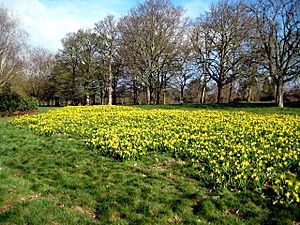
Cassiobury Park
The name Cassiobury has been spelled differently over time. It comes from 'Caegshoe', which likely combines a person's name ('caeg') and 'hoe' (meaning a piece of land). When the land was given to Sir Richard Morrison in the 1500s, it was called 'Cayshobury', with 'bury' meaning a manor house.
Cassiobury Park was created from the grounds of Cassiobury House. It's a huge open space, covering about 190 acres (0.77 square km). The original house was pulled down in 1927, and the Cassiobury Gates were removed in 1970 to make way for road widening. In 2007, the park won a Green Flag Award, which means it's one of the best green spaces in the country. There's a children's play area with a paddling pool, play equipment, and a miniature railway. The Grand Union Canal also runs through the park. Cassiobury Park also hosts a weekly 5k running event called parkrun.
Cheslyn House and Gardens
Cheslyn Gardens has also won Green Flag status since 2009. It opened to the public in 1965 as a formal garden with a house. The 3.5-acre (1.4-hectare) gardens have a formal open area at the front and a more natural woodland area at the back. Henry and Daisy Colbeck, who originally owned the house, designed the gardens. They travelled a lot, which is why the gardens have many unusual and exotic plants. Since opening to the public, new features like a pond, rock garden, and aviary have been added.
Woodside Park
Woodside Playing Fields, which also has Green Flag status since 2011, covers about 59 acres (24 hectares) of sports fields and woodland. It has many sports facilities, including an eight-lane running track and stadium, an indoor bowls green, and football pitches. Woodside Stadium is home to the Watford Harriers Athletics Club and hosts national sports events.
Historic Buildings in Watford
Watford has 92 buildings that are protected as nationally listed buildings. These include St Mary's Church, which dates back to the 1100s, and Holy Rood Church from 1890.
St Mary's Church is known for its beautiful interior, which was updated in 1850. It has lovely oak pews in the Gothic Revival style. It also has the Essex Chapel, where important people from the Cassiobury Estate, like the Earls of Essex, were buried. This chapel has many large, fancy marble tombs from the 1500s and later.
Holy Rood Church, a Roman Catholic church, was built much later in 1890. It was designed by John Francis Bentley, who also designed Westminster Cathedral in London. It's considered a great example of Gothic Revival architecture. The inside is very ornate, with stained glass windows by designer Nathaniel Westlake.
The Bushey Arches Viaduct is also a protected building. It was built in the 1830s for the London and Birmingham Railway. It crosses a roundabout at the bottom of the Lower High Street. A bit further northwest, the Colne Viaduct crosses the river. After that, the railway goes into Watford Tunnel. The south entrance of the original tunnels is beautifully decorated and is also a protected building.
Watford has ten special conservation areas, one protected park, and 240 buildings listed for their local importance.
Theatres in Watford
Watford Palace Theatre
The Watford Palace Theatre opened in 1908. It's the only theatre in Hertfordshire that produces its own shows. Each year, it puts on a traditional pantomime, new plays, dance shows, and family performances. Located just off the High Street, this Edwardian theatre has 600 seats and was renovated in 2004. The Palace has its own rehearsal room, costume department, cafe, and bar. It also shows films and live broadcasts of opera and ballet.
Pump House Theatre
The Pump House Theatre and Arts Centre is in an old pumping station near the Lower High Street. The building was turned into a theatre, with rehearsal rooms and a meeting place for local arts groups. It now has a 124-seat theatre, rehearsal rooms, and a live music venue. Many community groups meet here, including dance groups, jazz clubs, and theatre groups for children and adults. In 2018, it hosted the first Watford Short Film Festival.
Watford Colosseum
Watford Colosseum is a popular entertainment venue in the town. It was built in 1938 as the Assembly Rooms for Watford Town Hall. The building was improved in 2011 with new meeting spaces, a restaurant, and bar. Famous performers like opera singers Maria Callas and Luciano Pavarotti have performed here. The Colosseum is often used to record film soundtracks and hosts concerts by the BBC Concert Orchestra. Bands like The Who, Robbie Williams, and Oasis have also played here.
The Colosseum is also an important place for boxing matches. It has also hosted popular plays and charity events. The 2020 Snooker Shoot Out tournament was held at the Colosseum in February 2020.
Museums in Watford
Watford Museum, located in an old brewery building on the Lower High Street, has a collection of fine art and sculptures. These include works by famous artists like J. M. W. Turner and William Blake. The museum also has special collections about the Cassiobury Estate, Watford Football Club, and local history. It keeps old documents, photos, and diaries about Watford's people, government, and businesses.
The Hertfordshire Fire Museum is dedicated to the history of firefighting in the county. It's in a special building at Watford Fire Station, on the same street as Watford Museum. The museum has a wide range of old fire vehicles, equipment, uniforms, and historical documents.
Warner Bros. Studios, Leavesden is a huge film studio complex that has been used for many Hollywood movies. Part of the site is open to the public for the Warner Bros. Studio Tour London – The Making of Harry Potter. Here, you can see costumes and sets from the Harry Potter films, which were made at Leavesden. The studios are north of the town centre, about 2.5 miles (4 km) away. A special shuttle bus runs from Watford Junction station to the studios.
Transport in Watford
Road Travel
Watford is about 15 miles (24 km) northwest of central London. After World War II, many new roads were built, so Watford is now close to several major motorway junctions on both the M1 motorway and the M25 London Orbital Motorway.
Bus Services
Watford has many different bus companies, including Arriva, Carousel Buses, and London Sovereign. You can use Oyster Cards on some London bus routes (142 and 258) that go into London. Other bus passes like Intalink Explorer are accepted on most local routes.
The hourly Green Line bus route 724 connects Watford Junction station and the town centre to London Heathrow Airport on weekdays. Regular bus services run between Watford and Luton, but not directly to Luton Airport.
Train Services
Watford has five railway stations and one London Underground station. Watford Junction is on the West Coast Main Line, with trains going from London Euston to the Midlands, the North West, and Scotland. A journey to London Euston usually takes about 16 minutes without stops. The station is mainly served by frequent local and regional trains operated by London Northwestern. These trains go to Tring and Milton Keynes. There's also a cross-London service by Southern to Clapham Junction. Two local train services end at Watford Junction: the London Overground service to Euston, and the Abbey Line shuttle service to St Albans Abbey.
The London Overground service from Watford Junction goes south through a loop and stops at Watford High Street, before continuing through Bushey to London Euston.
Watford tube station is the end of the Watford branch of London Underground's Metropolitan line. This station is located outside the main centre of Watford, near Cassiobury Park.
You can also get direct train services from Watford Junction to Birmingham International station, which is useful for Birmingham Airport.
| Pic | Station | Services | Notes |
|---|---|---|---|
 |
Watford Junction | Main line services and local trains Abbey Line |
|
 |
Watford High Street | Watford DC Line | |
 |
Watford North | Abbey Line | |
 |
Garston | Abbey Line | |
 |
Watford tube station | Metropolitan line |
Waterways
Watford is on the main Grand Union Canal route that goes north from London. It's not used much for commercial transport anymore, but people use the canal for fun activities like boating. The River Gade and the River Colne also flow through Watford.
Cycling in Watford
Watford town centre and the areas around it are fairly small and mostly flat, which is good for cycling. Over 9 miles (14 km) of new cycle routes have been built in the town since 2003, and there are local cycle maps available. In Watford, 2.2% of people cycle to work, which is higher than the 1.6% across all of Hertfordshire.
National Cycle Routes 6 and 61 run along the eastern and southern parts of the town, using off-road paths like the Ebury Way. There's a continuous cycle route through the town centre, including pedestrian areas. You can find places to park your bike in the town centre and other local areas.
North of Watford Expression
There's a common saying, North of Watford, which means places north of Greater London. Sometimes, North of Watford Junction is used with a similar meaning, referring to Watford Junction railway station as the last big town stop on the main railway line leaving London Euston. This phrase was used even before the M1 motorway's Watford Gap services existed, but today it might refer to either Watford town or the Watford Gap services.
Education in Watford
The first records of schools in Watford mention a schoolmaster in 1595 and a Free School in 1640. In 1704, Elizabeth Fuller built a new Free School for 40 boys and 20 girls near the churchyard. In the mid-1800s, other schools included Fuller's Free School (which was in poor condition) and separate boys' and girls' schools called St Mary's National Schools. All of these offered basic education.
The Free School closed in 1882. Its money helped start the Watford Endowed Schools, which offered secondary education and charged fees. These schools, now called the Watford Grammar School for Boys and the Watford Grammar School for Girls, moved to new locations in the early 1900s. The old building then became the Watford Central School, teaching students up to age 14.
St Mary's National Schools closed in 1922, and the site is now a car park. The London Orphan Asylum, later Reed's School, was located near Watford Junction station from 1871 to 1940.
The only independent secondary school in the borough is Stanborough School, which is a day and boarding school run by the Seventh-day Adventist Church. There are also other independent schools nearby, such as the Purcell School, which is a special music school.
All state-funded primary schools in Watford teach both boys and girls together. Most schools have combined to become Junior Mixed Infant schools or primary schools.
Even though all state-funded secondary schools in Hertfordshire are comprehensive (meaning they take students of all abilities), there are some differences in the southwest part of the county, around Watford. In this area, there are:
- Partially selective schools: These schools offer some places based on ability or talent, and other places to siblings or those living close by. Examples include Parmiter's School, Queens' School, Rickmansworth School, St Clement Danes School, Watford Grammar School for Boys, and Watford Grammar School for Girls.
- Bushey Meads School: This school selects 10% of students for their technological ability.
- Roman Catholic schools: These schools, like St Joan of Arc Catholic School and St Michael's Catholic High School, do not select students based on ability.
- Other non-selective schools: These include Future Academies Watford, The Grange Academy, and Westfield Academy. Their student intake is affected by the partially selective schools.
- Falconer School: This is a school for boys who have emotional and behavioural difficulties.
- University Technical College: The Watford UTC was a school for 14-19 year olds that operated from 2014 to 2023.
The partially selective schools and Bushey Meads School use common tests in maths and non-verbal reasoning each autumn. Most Year 6 children in the area take these tests. The partially selective schools also have a common test and audition process for students wanting specialist music places.
The results that schools achieve in GCSE exams vary widely in Watford. The Watford Campus of West Herts College is a highly-rated further education college. The Centre for Missional Leadership (CML) is the Watford branch of the London School of Theology, which is Europe's largest evangelical theological college.
Media in Watford
Television
Watford is in the BBC London and ITV London television regions. TV signals come from the Crystal Palace TV transmitter and a local relay transmitter in Hemel Hempstead.
Radio
Local radio stations include BBC Three Counties Radio on 92.1 FM, Heart Hertfordshire (which has studios in Watford) on 96.6 FM, and community stations like Vibe 107.6 FM. Watford Hospital Radio, known as The Pulse Hospital Radio, broadcasts to patients at the Watford General Hospital.
Newspapers
The Watford Observer is the town's local weekly newspaper.
Sports in Watford
The professional football team Watford F.C. plays in the EFL Championship in the 2022–2023 season. Watford reached the 1984 and 2019 FA Cup Finals. They also finished second in the top league (now the Premier League) in 1983. The club was promoted to the Premier League in 1999 and again in 2006 and 2015. Famous singer-songwriter Sir Elton John is a big fan of Watford FC and used to be the club chairman. He is still the Honorary Life President. From 1997 to 2013, the club shared its home ground, Vicarage Road, with Saracens Rugby Football Club.
Other sports teams include Sun Sports FC (a non-League football team), the Watford Cheetahs (an American football team), Glen Rovers (who play hurling and Gaelic football), and Watford Town Cricket Club.
Notable People from Watford
Freedom of the Borough
The following people and military groups have been given the special title of Freedom of the Borough of Watford:
Individuals
- George Villiers, 6th Earl of Clarendon: 28 July 1924.
- Dennis Herbert, 1st Baron Hemingford: 22 March 1943.
- Sir Elton John: 6 October 1977.
- Sir Raphael Tuck: 15 November 1980.
- Graham Taylor: 25 June 2001.
- Luther Blissett: 18 October 2021.
Military Units
- 1st East Anglian Regiment: 1959.
- Royal Anglian Regiment: 1964.
See also
 In Spanish: Watford para niños
In Spanish: Watford para niños


